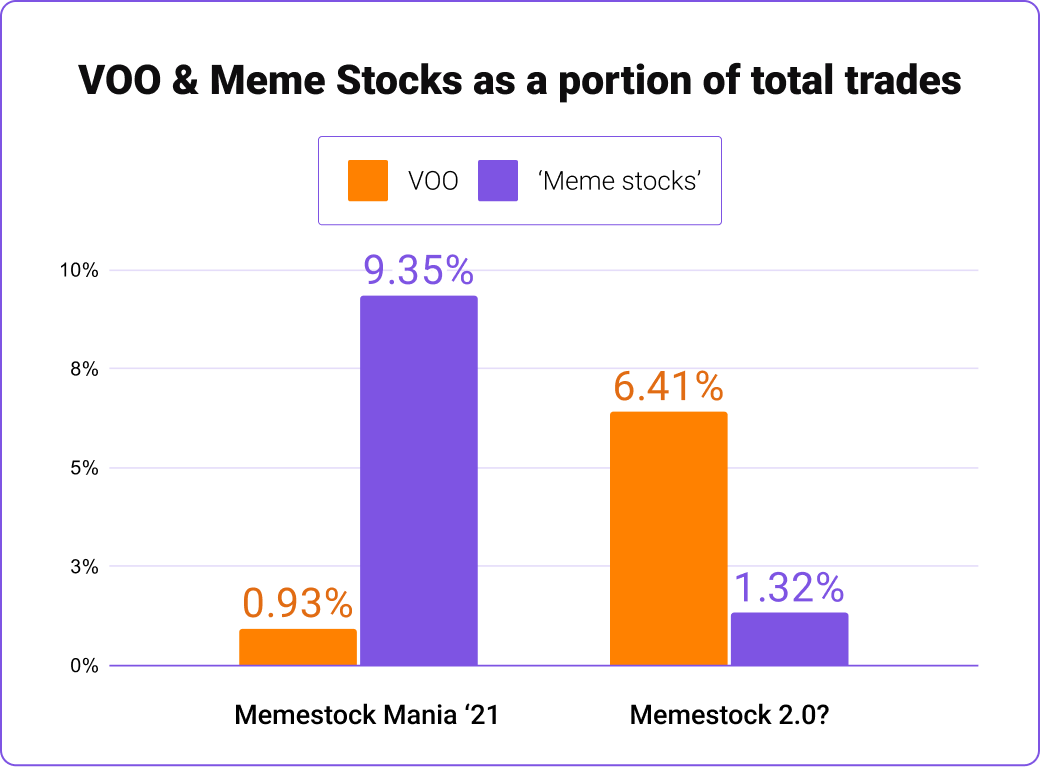Join the Kiwis who are hatching their tomorrow and have invested more than $2 billion with Hatch.
Is this a return to partying like it’s 2021? 🥳
If it all feels a bit like déjà vu, this could be why. Meme stock mania in 2021 and the dot-com bubble are the only times the stock market has been more speculative than it is now, according to Goldman Sachs’ Speculative Trading Indicator. The investment bank pointed out that the Full Moon party-like frenzy is being driven by 'elevated recent share trading volumes in unprofitable stocks, penny stocks, and stocks with elevated EV/sales multiples'.
Trading volumes of some more speculative stocks are climbing the global ranks, including BigBear.ai (BBAI), which also edged ahead of Alphabet (GOOGL) to be Hatch Investor’s 10th most traded in July. Like a 3 am feed of fried chicken from Night 'n Day, some investors appear to have an increased appetite for risk. Goldman Sachs points to indicators of this as an increase in call option volumes, and a comeback for IPO’s and SPACs. Heck, even Chamath is back in action. 👀
Hatch Investors' behaviour says 2021’s party might have come with a hangover that some don’t want to repeat. We asked the Hatch Investor’s Club, and yes, lessons were learned. Comparing trading activity on Hatch in the Vanguard S&P 500 (VOO) to trading in meme stocks over early 2021 to now, *so far* things are looking very different.

In this example, we’ve defined meme stocks as 2021’s original lineup of GameStop (GME), AMC (AMC), Blackberry (BB), Bed Bath Beyond (Formerly of the ticker BBBY but since delisted). The new wave (and its questionable acronym) are defined here as Krispy Kreme (DNUT), OpenDoor (OPEN), Rocket Cos (RKT), and Kohl’s (KSS).
Read more: The Vanguard S&P 500 and the S&P 500 Index
But what does it all meme? 💎🙌
2021 gave us a parking fail that halted global trade, an Olympic Games with no spectators, and meme stocks. The meme stock craze of 2021 was an outlier for many reasons, but was it as chaotic as it seemed? The sudden rise of retail investing platforms gave access to the markets with the aim to ‘democratize finance’, and Robinhood retail investors took that meaning to a whole new level. 🚀
To scratch the surface of the story behind the ‘stonks’, you could watch the movie adaptation, enroll in a paper at university, or read the articles below;
'I like the stock' Reuters unmasked Keith Gill, aka Roaring Kitty, aka u/DeepF–ingValue, as a driving factor behind the GME short squeeze.
The power of collectivism. CNBC looked at how the trading frenzy exposed market inefficiencies and the power of retail investors in disrupting Wall Street.
Dumb Money? Time Magazine reflected on how everyday investors drove stocks to shocking prices and painful losses, created a cultural movement, and put the spotlight on financial awareness for a new generation.
Since 2021, retail investors have become a driver in shaping market momentum and sentiment, perhaps spurred on by our early meme stock forefathers’ understanding of their ability to go against the norm and the power of working together. Or was it all just herd behaviour? 🐑 Of the thousands of people who started investing through Hatch during meme stock mania, just 3.7% made their first investment in a meme stock. 96% of those investors didn’t follow the hype and made their first investment in one of the other 5,900 companies and ETFs available on Hatch. 😉
Oh, Behave!🤓
Have you ever started assembling flatpack furniture with an excess of confidence (and a lack of instructions) and had to start over? 🙋♀️ Or kept a gym membership you never use because cancelling would be admitting to failure? Sometimes our counterproductive or irrational actions can come from cognitive biases, and this can also impact the way we invest.
Behavioral finance (a field in behavioural science) looks at how cognitive biases, emotions, and social pressures influence investor behaviour, and the effects this can have on the share markets. A few examples;
- Overconfidence: A few lucky trades, and suddenly you’re the next Warren Buffett. Overconfidence can lead to investing more than you usually would, trading more frequently, and taking excessive risks.
- Loss aversion: We put greater value on eliminating the probability of a loss while ignoring the potential of a gain. This can mean poor decisions on timing when to sell, or when to buy. Why? Because losing hurts!
- Anchoring: This bias makes investors fixate on a reference point that may be completely irrelevant, such as a stock's historical high price, when making investment decisions.
- Herd behavior: Ask yourself, does this flock of financial ‘gurus’ have the same goal, timeline, monetary means, and skill level as you? If you’re following the crowd instead of doing your research (YOLO’ing into stocks, for example), you might have fallen into the trap of herd mentality.
Could basic psychology help you make smarter choices with your investment portfolio? Using a cognitive bias checklist could help to identify your blind spots when making financial decisions. Another tip is keeping an investment journal, or a log of your investments and the reasoning behind the purchase. Not only is it good to reflect on your investments and look for possible patterns in behaviour, but it could come in handy at tax time.
We’re not financial advisors and Hatch news is for your information only. However dazzling our writing, none of it is a recommendation to invest in any of the companies or funds mentioned. If you want support before making any investment decisions, consider seeking financial advice from a licensed provider. We’ve done our best to ensure all information is current when we pushed ‘publish’ on this article. And of course, with investing, your money isn’t guaranteed to grow and there’s always a risk you might lose money.








.png)